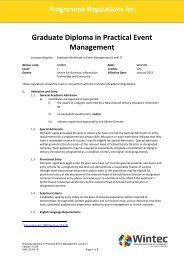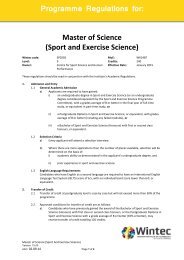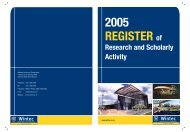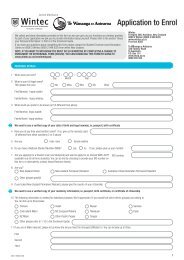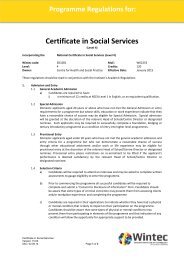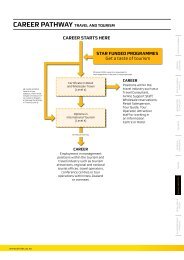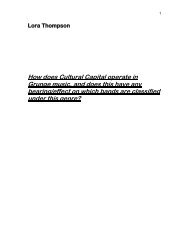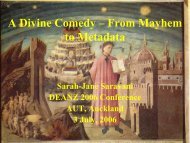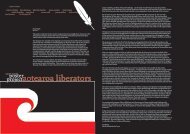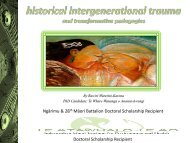Stimulated recall - Wintec Research Archive
Stimulated recall - Wintec Research Archive
Stimulated recall - Wintec Research Archive
You also want an ePaper? Increase the reach of your titles
YUMPU automatically turns print PDFs into web optimized ePapers that Google loves.
STIMULATED<br />
RECALL<br />
Jonathon Ryan
OUTLINE<br />
<strong>Research</strong>ing miscommunication: The case for <strong>Stimulated</strong> Recall (SR)<br />
Characteristics of SR<br />
Outline of the present study<br />
Discussion of methodological issues<br />
Implications of key findings
IDENTIFYING MISCOMMUNICATION<br />
Each method has substantial limitations:<br />
Self-reporting (e.g. miscommunication diaries) (e.g. Milroy, 1986)<br />
Close analysis of recordings and transcripts (e.g. Schegloff, 1987)<br />
Task completion (e.g. Brown, 1995)<br />
Mixed methods are often used (e.g. Tzanne, 2000)
STIMULATED RECALL
DEFINING SR<br />
SR is a type of retrospective report<br />
Involving the retrospective verbalization of cognition<br />
Contrasts with Think Aloud: concurrent verbal reporting<br />
Contrasts with other types of retrospective report<br />
Through the use of a <strong>recall</strong> stimulus<br />
Focuses on cognition at the time of the event (not<br />
informed by subsequent events)
STIMULATED RECALL: BASIC PROCEDURES<br />
An event is observed and recorded<br />
Participants are interviewed<br />
A stimulus is used to prompt <strong>recall</strong> of the event<br />
Participants verbalize the thoughts they had during the event (not<br />
reflections on the event)
DOES IT PRODUCE USEFUL DATA?<br />
At its best, SR enables participants “to relive an original situation with<br />
vividness and accuracy” (Bloom, 1953, p. 161)<br />
However, for much of the 20 th century, researchers treated verbal<br />
reports with suspicion<br />
Undoubtedly, SR data is easily compromised and a great deal of caution<br />
is required when collecting and interpreting it
THEORETICAL JUSTIFICATION<br />
Ericsson & Simon (1984) provided a theoretical justification for<br />
accepting certain types of verbal report as ‘hard’ data:<br />
In completing a task, “a durable (if partial) memory trace is laid<br />
down” of the information that informed the behaviour<br />
“This trace can be accessed from [short-term memory], at least in<br />
part, or retrieved from [long-term memory] and verbalized.”<br />
Both “are direct verbalisations of specific cognitive processes.”<br />
However, the latter “will require an additional process of retrieval”<br />
and may display errors and incompleteness.” (p. 16)
AREAS OF PREVIOUS ENQUIRY<br />
Most often used to explore the cognition behind participants’ actions, e.g.<br />
teacher cognition (Polio, et al., 2006)<br />
learner cognition (Lam, 2008)<br />
language processing in translation (Dechert, 1987)<br />
learner reflection and self-evaluation (Murray, 2010)<br />
Less frequently used to explore hearer responses to discourse:<br />
Tyler’s (1995): the perceptions of conversational interactants<br />
Bloom’s (1953): students’ thoughts during lectures and tutorials<br />
“The great majority of such studies treat the procedures involved as<br />
unproblematic and few studies report the SR protocol in critical detail”<br />
(Lyle, 2003, p. 861)
THE STUDY
THE PRESENT STUDY<br />
Acts of reference: where speakers identify for the hearer a<br />
specific individual (e.g. by saying that man or Charlie or he)<br />
Referential miscommunication: when the hearer misidentifies<br />
who the speaker means<br />
<strong>Research</strong> Question: What linguistic factors are implicated in<br />
referential miscommunication in L1-L1 and L2-L1 narrative<br />
discourse?
PARTICIPANTS<br />
60 participants in 30 dyads<br />
10<br />
L2 speakers + L1 hearers<br />
10<br />
L2 speakers + ESL teachers<br />
10<br />
L1 speakers + L1 hearers
PROCEDURES
EXAMPLES FROM THE STUDY<br />
Narrative retelling<br />
A – Charlie falls on the fat<br />
woman, like two times and she’s<br />
all like like this (GESTURE)<br />
B – [LAUGHS]<br />
A – and then um she like gets<br />
up and looks real mad?, like her<br />
face?, and then suddenly like she<br />
pushes the policeman or<br />
something,<br />
SR interview<br />
Part 1<br />
Res – who got up and looked<br />
mad?<br />
B – the fat woman<br />
Part 2<br />
B – ah, it WAS her [[the banana<br />
girl]], [LAUGHS] I thought the fat<br />
angry woman got angry
EXAMPLES FROM THE STUDY<br />
Narrative retelling<br />
S – so, you know at the last<br />
part, we see together, when<br />
they bringed the machine?<br />
SR interview<br />
A – when she said the machine,<br />
I thought of two machines<br />
obviously . . . . there was the<br />
conveyor belt,<br />
Res – ah, and that other one<br />
A – and the other big machine<br />
where the guy talked to him<br />
and he changed the speeds
S – I noticed he was um, . like . his English definitely wasn’t perfect, but . .<br />
like . he he did make quite a few mistakes, I noticed one that I can sort<br />
of just remember off the top of my head [okay] he said ‘him’ instead of<br />
‘her’ . um, a couple of times I think<br />
R – Oh, okay, . and was that confusing?<br />
S – Well it wasn’t confusing because I knew what he was talking about,<br />
and that’s the other thing I was going to get to, I mean, even though he<br />
made quite a few mistakes, . I still figured out what he was on about,<br />
[some comments omitted] yeah, I mean . . I picked up on it straight away,<br />
pretty much [yep, okay] and knew exactly who he was talking about
MISPLACED CONFIDENCE<br />
However, the SR interview revealed that the hearer had a radically<br />
different interpretation of the narrative (see Ryan & Barnard, 2009)<br />
The miscommunications largely hinged on a small number of<br />
mispronounced words:<br />
Shake – choke<br />
Spilled – spit<br />
‘Lunch machine’ (feeding machine) – (cleaning up machine)<br />
Corn – comb
USING STIMULATED RECALL
PITFALLS<br />
There are multiple pitfalls in implementing SR procedures (see Gass &<br />
Mackey, 2000:84-99), and so it is of some concern to Lyle that few<br />
studies “treat the procedures involved as unproblematic and few studies<br />
report the SR protocol in critical detail” (2003:861).<br />
Lyle (2003) warns that care is required to minimize the risk of SR data<br />
not accurately representing cognitive processes from the time of the<br />
original event, particularly in relation to processes such as re-ordering,<br />
reasoning, and ‘sanitization’.
BEST PRACTICE PROCEDURES<br />
Lyle (2003, pp. 865-866)<br />
“It is necessary to reduce anxiety;<br />
limit the perception of judgemental probing;<br />
reduce the intrusion into the action;<br />
stimulate rather than present a novel perspective/insight;<br />
make the retrospection as immediate as possible;<br />
allow the subject a relatively unstructured response;<br />
and employ an 'indirect' route to the focus of the research.”
VIDEO<br />
Video is generally regarded as providing the strongest <strong>recall</strong> stimulus<br />
It is the most widely used stimulus in current research<br />
However, “it is possible that using videotapes for stimulated <strong>recall</strong><br />
produce a much more foreign stimulus than audiotapes” (Yinger,<br />
1986:271)<br />
Most people are not accustomed to seeing themselves on video<br />
The participants often appeared distracted by their own image<br />
My response: train cameras on the speakers
RECALL QUESTIONS<br />
Participants are to comment on memories rather than on a present<br />
interpretation<br />
Questions posed in the past tense<br />
Placement of adverbial time markers:<br />
What did you think she think she meant when she first said that?<br />
When she said first said that, what did you think she meant?<br />
at the beginning of an utterance rather than at the end
TIME ELAPSE<br />
The delay between the event and the interview is critical<br />
Time elapse leads to memory decay<br />
But analysis of recordings is useful for identifying<br />
troublespots<br />
The dilemma:<br />
Analyze the recordings first?<br />
Or commence the SR immediately?
TIMING OF THE RECALL PROMPT<br />
Where do you pause the recording?<br />
they all stopped and had lunch and he . . .<br />
they all stopped and had lunch and he still had twitches<br />
Suggestion: pause recordings only at natural discourse<br />
boundaries
THE FOCUS OF RECALL QUESTIONS<br />
When she said ‘that big guy’, who did you think she meant?<br />
Who stole the bread?<br />
What was your understanding of the film at this point?<br />
What was your mental picture of what was happening here?
DECLARATIVE AND PROCEDURAL<br />
KNOWLEDGE
LEADING QUESTIONS?<br />
M – so . um the girl runs out of the car, Charlie Chapman follows, the<br />
cop follows, and they all fall down, . . . the cop’s somehow . still on the<br />
ground?, unconscious or something?,<br />
R – okay<br />
M – he must have donked his head, but I – I'm just filling in a gap,<br />
R – yeah, okay<br />
M – and then she explains something about Charlie Chapman hits him<br />
on the head again,<br />
R – hits the policeman?<br />
M – hits the policeman with a stick, and then they managed to get away<br />
R – okay
M – he must have donked his head, but I – I'm just filling in a gap,<br />
R – yeah, okay<br />
M – and then she explains something about Charlie Chapman hits him<br />
on the head again,<br />
R – hits who?<br />
There is a need to ask confirming questions<br />
There is sometimes a tension between not leading the participant and<br />
needing to present yourself as a cooperative listener<br />
Suggestion: Use leading questions to confirm an interpretation you are<br />
fairly confident of (see also Kvale, 1996, p. 158)
FACE THREATS<br />
Miscommunication is face threatening (Tzanne, 2000)<br />
Speakers wish to be viewed as competent communicators<br />
Hearer’s may wish to protect the speaker’s face<br />
Hearer’s wish to appear intelligent and cooperative but are<br />
“at risk of appearing slow-witted” (Smith et al., 2005, p. 1871)<br />
Highlights need to minimize participant anxiety (cf. Bloom, 1953)
REFERENCES<br />
Bloom, B. (1953). Thought processes in lectures and discussions. Journal of General Education, 7, 160-169.<br />
<br />
<br />
<br />
<br />
<br />
<br />
Dechert, H. W. (1987). Analysing language processing through verbal protocols. In C. Færch & G. Kasper (Eds.), Introspection in<br />
second language research (pp. 96-112). Clevedon, England: Multilingual Matters.<br />
Ericsson, K. A., & Simon, H. A. (1984). Protocol analysis: Verbal reports as data. Cambridge, MA: MIT Press.<br />
Gass, S. M., & Mackey, A. (2000). <strong>Stimulated</strong> <strong>recall</strong> methodology in second language research. Mahwah, NJ: Lawrence Erlbaum.<br />
Kehler, A. (2002). Coherence, reference, and the theory of grammar. Stanford, CA: CSLI Publications.<br />
Kvale, S. (1996). InterViews: An introduction to qualitative research interviewing. Thousand Oaks, CA: Sage.<br />
Lam, W. Y. K. (2008). Metacognitive strategy use: Accessing ESL learner's inner voices via stimulated <strong>recall</strong>. Innovation in Language<br />
Learning and Teaching, 2(3), 207-217.<br />
Lyle, J. (2003). <strong>Stimulated</strong> <strong>recall</strong>: A report on its use in naturalistic research. British Educational <strong>Research</strong> Journal, 29(6), 861-878.<br />
<br />
<br />
<br />
<br />
<br />
Murray, J. (2010). Politeness and face in professional speaking tests. Paper presented at the 18th international conference on<br />
pragmatics & language learning.<br />
Polio, C., Gass, S., & Chapin, L. (2006). Using stimulated <strong>recall</strong> to investigate native speaker perceptions in native-nonnative<br />
speaker interactions. Studies in Second Language Acquisition, 28(2), 237-267.<br />
Tyler, A. (1995). The coconstruction of cross-cultural miscommunication: Conflicts in perception, negotiation, and enactment of<br />
participant role and status. Studies in Second Language Acquisition, 17(2), 129-152.<br />
Tzanne, A. (2000). Talking at cross-purposes: The dynamics of miscommunication. Amsterdam, The Netherlands: John Benjamins.<br />
Yinger, R. J. (1986). Examining thought in action: A theoretical and methodological critique of research on interactive teaching.<br />
Teaching & Teacher Education, 3(2), 263-282.



